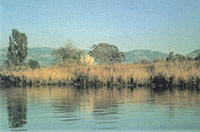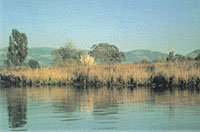This essay is excerpted from The New Economy of Nature: The Quest to Make Conservation Profitable.
In a cattle pasture south of downtown Napa, Calif., a clarinet, flute, and bass guitar strike up a jazzy version of “Up a Lazy River.” About sixty people, if you count the rubberneckers wandering over from a nearby retirement house, gather in the midsummer sun. Two young women in flowing dresses open paper boxes to release orange clouds of monarch butterflies. A few dogs wander through the crowd.

The Napa River.
Photo: City of Napa.
It’s a markedly mellower scene than your average U.S. Army Corps of Engineers groundbreaking ceremony. Yet the mood of this morning, in late July 2000, is triumphant. This blue-collar, backwater city has fought Washington, D.C., and won. It has taken control of the shape of its future, declared its right to choose its battles — and now, with low-key pomp, it is celebrating a promising armistice.
For several decades, Napa, the depressed county seat of the glamorous grape-growing valley that bears its name, had lived at war with the river that runs through it. The 55-mile-long waterway, meandering from the high country redwoods of Mt. St. Helena through vineyards and marshes to San Pablo Bay, near San Francisco, was pinched and squeezed by earthen levees and low concrete bridges that blocked its flow when the water ran high. It was corseted, in the words of one city mother, like the Victorian ladies who once strolled its docks. But the river was no lady, and periodically, after heavy rains, it would burst from its jackets and flood, costing increasing fortunes in property damage and disaster aid.
The Corps, the main federal agency in charge of flood control, proposed a remedy. The river would be forced into a deep concrete channel running in a straight line through the city. Concrete steps would line its banks; rocky riprap would constrain it. Yearly dredging would speed the water along and chin-high walls block its periodic fury. Riverside marshes would be stripped, with the damage “mitigated” by restoration of wetlands someplace else.
There was just one problem. Napa residents, by law, would have to foot as much as half of the bill, and they balked at the Corps’ aggressive river-subduing plan. So instead, in a process that took several years and several million dollars’ worth of studies, residents came up with their own design, a friendly truce that would preserve the river’s integrity while containing its rage. They called it a “living river” approach, and it held the promise of bringing the city’s submerged economy back to life.
Green Gold
Proponents of the living river approach said they’d work with nature rather than trying to tame it; they’d let the Napa River be a river. The waterway and its adjoining land would be coaxed back into ancient patterns. Planners would relocate homes, businesses, and even railroad tracks built on the floodplain and would bar future development there. The Corps, in a stunning reversal of approach, would raze levees and either remove bridges or rebuild them at higher levels. More than 650 acres of wetlands would be created or restored — even right in the middle of downtown, where an oil-storage facility once stood — and the land would periodically sop up floodwaters as it had done in centuries past.

New Economy of Nature:
The Quest to Make
Conservation Profitable
By Gretchen C. Daily and
Katherine Ellison
Island Press, 250 pages, 2002
At its conception, in the mid-1990s, it was a pathbreaking idea, although it wasn’t entirely original. A decade earlier, after a devastating 1984 flood, Tulsa, Okla., had defied tradition by moving some 1,000 structures out of its floodplain. Napa’s approach was much more comprehensive, however, and since its start, the idea of a river armistice has caught on in rain-soaked communities from Rapid City, S.D., and Louisville, Ky., to Argentina, Australia, and China. The scope for duplication in the future is great because the tactic is aimed at an age-old human problem. All over the world, people have crowded unwisely onto floodplains and filled-in wetlands, playing chicken with rivers that rise up every few years to teach them the same costly old lesson.
In contrast, Napa’s project and those that followed represent vivid progress toward the establishment of a new economy of nature, in which the labor of ecosystems is formally respected. The project got off the drawing board in 1998, after county residents voted to raise their own taxes to help fund it.
At the start, at least, Napa’s plan would cost taxpayers and the federal government much more than the Corps’ original scheme. But local environmentalists and city boosters alike hoped to profit from a host of extra benefits besides simple flood protection. In bringing back their river from the dead, they meant for it in turn to revive their beaten-down urban landscape, providing their city with lovely new natural settings that would encourage local commerce and tourism. Their hope was that, in the end, their plan’s net benefits would outweigh those of the Corps’ proposal. The cow-pasture groundbreaking ceremony marked the start of a grand experiment that would show whether the city’s “green gold” prospectors had dreamed an impossible dream.



